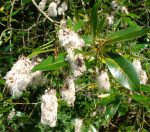 Also known as laurel willow, this deciduous shrub or small tree is native to northern Europe and northern Asia where it grows along streams and in marshes, fens, and wet woods. It is a member of the willow family, Salicaceae, that also includes aspen, poplar, and cottonwood. Plants grow 30-45′ tall and have broad glossy green leaves that are 1 1⁄2 to 4 1⁄2 ” long and have a sweet aromatic fragrance when dried or bruised. In late spring male and female catkins of inconspicuous flowers appear on different plants. The male catkins are yellow and showier than the green female catkins. Bay willow is considered one of the showiest of the willows and is valued for its handsome foliage as well as it tolerance of wet soil. The genus name, Salix, is the ancient Latin name for one of the species. The specific epithet, pentanda, comes from the Greek words penta, meaning five, and andros, meaning male and refers to the 5 stamens in the male flowers, although 5-8 may actually be present.
Also known as laurel willow, this deciduous shrub or small tree is native to northern Europe and northern Asia where it grows along streams and in marshes, fens, and wet woods. It is a member of the willow family, Salicaceae, that also includes aspen, poplar, and cottonwood. Plants grow 30-45′ tall and have broad glossy green leaves that are 1 1⁄2 to 4 1⁄2 ” long and have a sweet aromatic fragrance when dried or bruised. In late spring male and female catkins of inconspicuous flowers appear on different plants. The male catkins are yellow and showier than the green female catkins. Bay willow is considered one of the showiest of the willows and is valued for its handsome foliage as well as it tolerance of wet soil. The genus name, Salix, is the ancient Latin name for one of the species. The specific epithet, pentanda, comes from the Greek words penta, meaning five, and andros, meaning male and refers to the 5 stamens in the male flowers, although 5-8 may actually be present.
Type:Deciduous shrub or small tree
Outstanding Feature: Foliage
Form: Oval
Growth Rate: Rapid
Bloom: Yellow male and green female catkins of inconspicuous flowers on different plants in late spring; male catkins showier than female
Size: 30-45′ H
Light: Full sun
Soil: Average, consistently moist to wet, well-drained
Hardiness: Zones 2-5
Care: Low maintenance
Pests and Diseases: Aphids, caterpillars, willow anthracnose, canker, honey fungus, rust, watermark disease, and scab
Propagation: Greenwood cuttings in early summer or hardwood cuttings in winter
Photo Credit: Wikimedia Commons